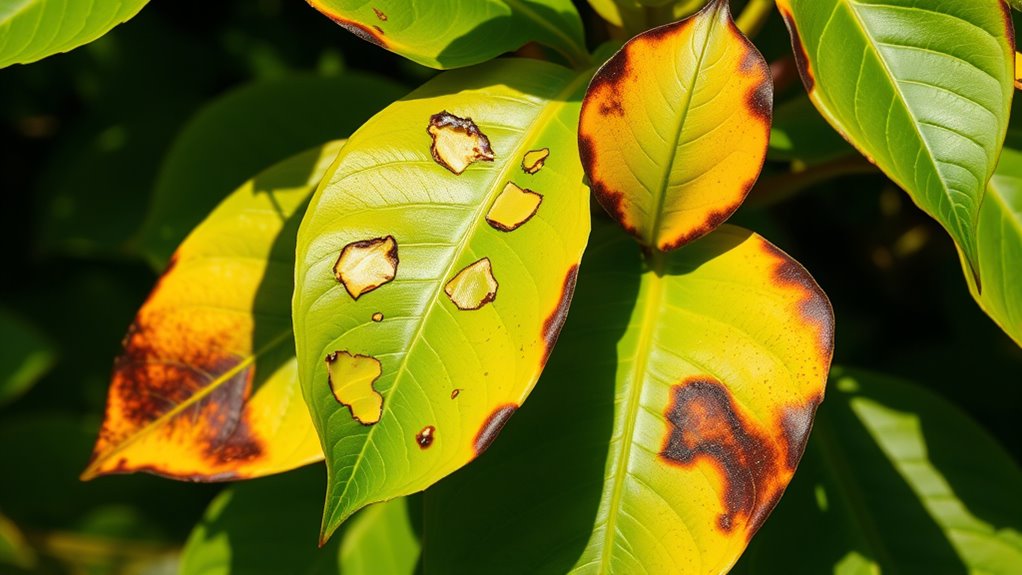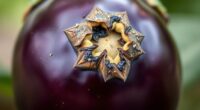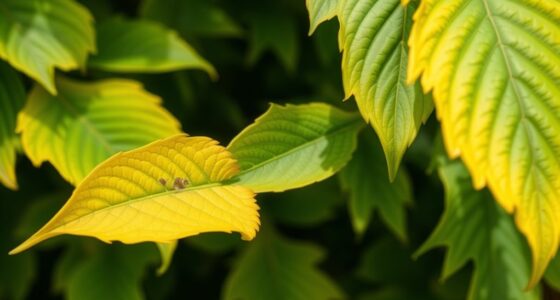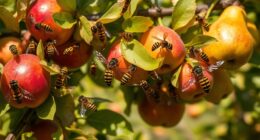To tell if your plumeria leaves are burning from sun scald or fertilizer burn, look at the symptoms: sun scald causes bleached, crispy patches on the sun-facing side with less tissue damage, while fertilizer burn leads to yellowing or browning leaf edges, often with dry, brittle tissue and scorch marks. Environmental factors and recent care routines help identify the cause. Keep exploring to learn how to prevent and treat these issues effectively.
Key Takeaways
- Sun scald causes leaf discoloration with faded patches and crispy edges, typically on the sun-facing side of the plant.
- Fertilizer burn results in yellow or brown leaf edges, with rough, crispy, or scorched tissue, often starting at tips.
- Sun scald is linked to high temperatures and intense sunlight, while fertilizer burn stems from excess salts and improper application.
- Sun damage usually appears as faded, sunburned patches, whereas fertilizer burn shows browning and dry, brittle leaf margins.
- Correct diagnosis involves examining leaf texture, color patterns, environmental conditions, and recent care practices.
Recognizing the Symptoms of Sun Scald on Plumeria Leaves
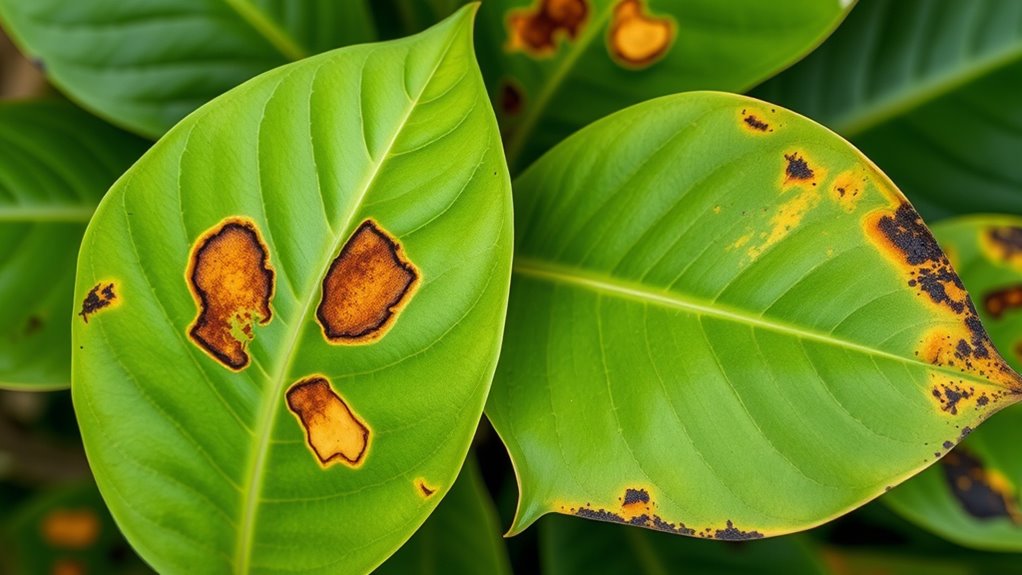
Recognizing the symptoms of sun scald on plumeria leaves is essential to prevent long-term damage. You’ll notice leaf discoloration, often appearing as scorched, bleached, or faded patches on the leaves’ surface. These areas may look sunburned, with edges that look burnt or crispy. Sun exposure causes this damage, especially if your plant is suddenly exposed to intense sunlight after being indoors or in shade. You might also see leaves curling or developing transparent spots, indicating stress from excessive heat and light. The discoloration typically starts on the side facing the sun and can spread if unchecked. By identifying these early signs, you can take steps to shield your plumeria, reducing further sun damage and promoting healthier growth.
Identifying Signs of Fertilizer Burn in Your Plant
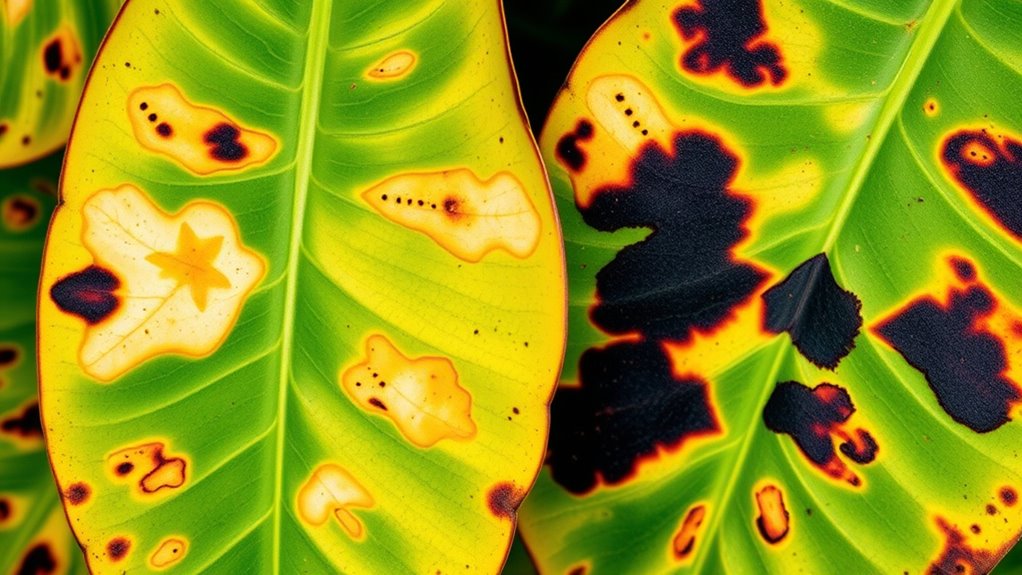
Just as sun scald leaves tell a story of too much sun exposure, signs of fertilizer burn reveal when your plumeria receives too much or too strong nutrients. You might notice leaf edges turning yellow or brown, often starting at the tips. The soil pH can also be affected, making it harder for your plant to absorb nutrients properly. Over-fertilizing can lead to salt buildup, causing leaf curling or spots that look burnt. To avoid this, revisit your watering schedule—frequent, heavy fertilizing without proper watering can intensify damage. Keep an eye on the overall health of your plumeria, and ensure you’re using the right fertilizer strength. Properly balancing soil pH and sticking to a consistent watering routine helps prevent fertilizer burn.
Key Differences in Leaf Appearance and Texture

Understanding the differences in leaf appearance and texture can help you quickly identify issues like fertilizer burn or environmental stress. Fertilizer burn often causes leaves to develop a rough or crispy leaf texture, with edges turning brown or scorched. You might notice color changes, such as yellowing or browning, especially around the margins. In contrast, sun scald typically results in sunken, blistered areas that look more transparent or shiny, with less drastic texture changes. The affected leaves may become dry or brittle but usually don’t exhibit the same scorched appearance as fertilizer damage. Additionally, understanding how plant health data analysis can analyze plant health data can assist in early diagnosis and prevention of such issues. By observing these subtle differences in leaf texture and color changes, you can better determine whether your plumeria is suffering from fertilizer burn or sun damage, enabling targeted treatment. Recognizing the signs of stress early can also help in implementing effective remedial measures.
Environmental Factors Contributing to Sun Damage
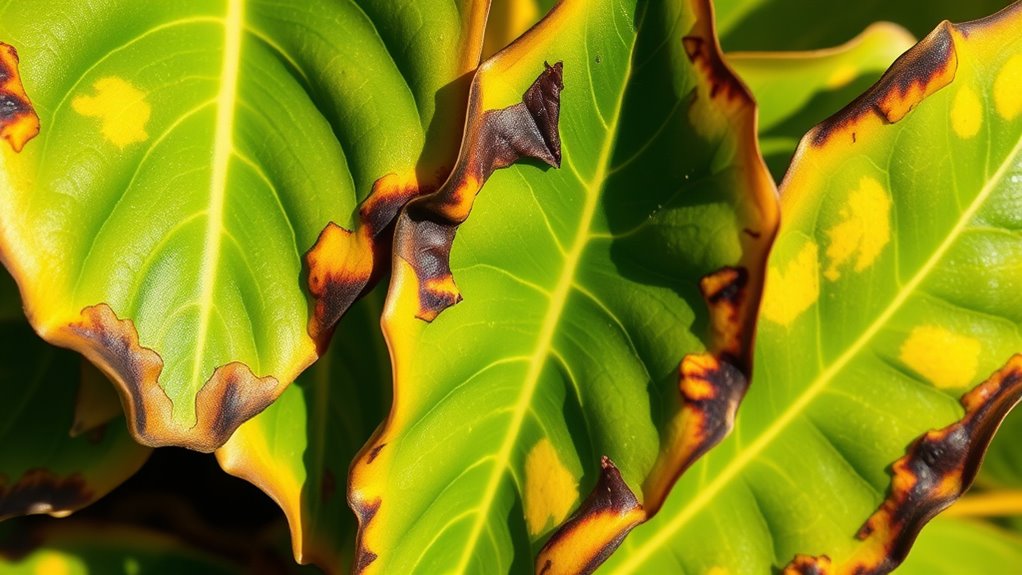
Environmental factors such as intense sunlight, high temperatures, and dry conditions can considerably increase the risk of sun damage to plumeria leaves. When exposed to these elements, your plant faces leaf scorch and drought stress, weakening its defenses. Sun scorch causes brown, scorched patches, leaving your plumeria looking battered. Drought stress hampers its ability to hydrate, making leaves vulnerable. To visualize the emotional impact:
| Condition | Effect on Your Plumeria |
|---|---|
| Intense sunlight | Causes leaf scorch, fading vibrant colors |
| High temperatures | Accelerates drought stress, wilting leaves |
| Dry conditions | Promotes drought stress, leaf browning |
| Drought stress | Leaves become fragile, prone to damage |
| Sun exposure | Triggers leaf scorch, weakening overall health |
Additionally, prolonged exposure to these environmental stressors can lead to plant weakening, making it more susceptible to pests and diseases.
Proper Fertilization Practices to Prevent Root Burn
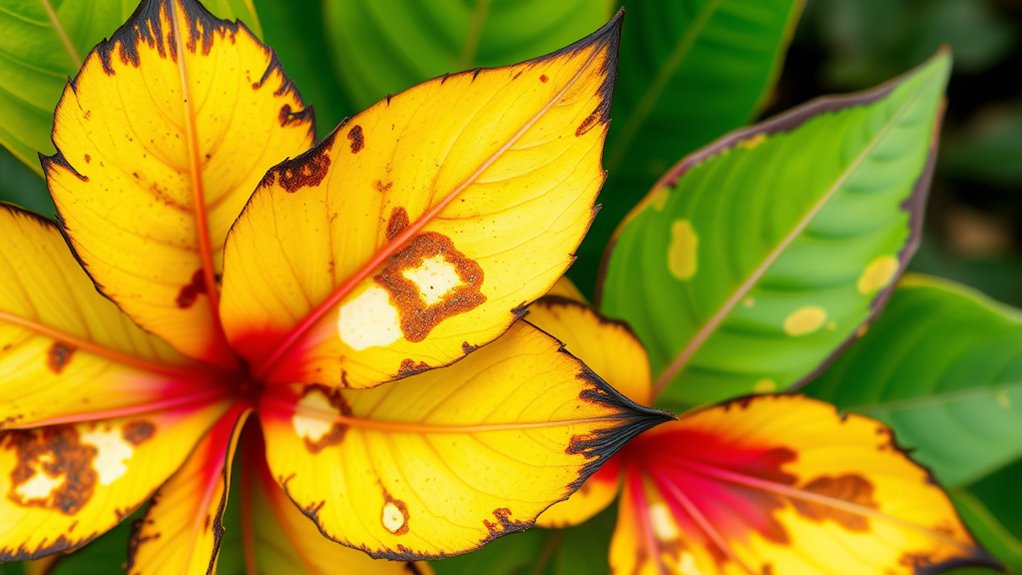
To prevent root burn, you need to use the right amount of fertilizer at the right times. Make sure you’re applying the correct quantity and avoid overfeeding your plumeria. Consistently following proper timing and frequency helps keep your plant healthy and avoids damage. Additionally, understanding the plant’s needs can foster a safe space for expressing its growth requirements through proper fertilization practices. Implementing regular audits of your fertilization schedule can further ensure that your plant’s nutritional needs are met without causing harm.
Correct Fertilizer Quantity
Applying the correct amount of fertilizer is essential to keep plumeria roots healthy and prevent burn. Too much fertilizer can lead to root damage, while too little won’t support healthy growth. Always follow the recommended dosage on the fertilizer label, adjusting for your plant’s size and age. Make certain your soil pH is balanced, as imbalanced pH levels can affect nutrient absorption and increase the risk of root burn. Maintaining a consistent watering schedule helps nutrients penetrate the soil evenly and prevents fertilizer buildup, which can harm roots. Regularly testing your soil helps you adjust fertilizer quantities appropriately. Remember, proper fertilization isn’t just about quantity but also about timing and balance, keeping your plumeria healthy and vibrant without risking root or leaf damage.
Timing and Frequency
Timing and frequency are essential to guarantee your plumeria receives nutrients without risking root burn. You should follow a consistent watering schedule, allowing the soil to dry slightly between waterings. Over-fertilizing too often can cause root damage, so adjust the frequency based on the plant’s growth stage and weather conditions. Proper pruning techniques also help manage nutrient uptake, preventing excessive growth that might lead to burn. Additionally, understanding fertilizer ingredients and their effects can help you select appropriate products to minimize the risk of root damage. Being aware of soil health and its influence on nutrient absorption can further enhance your fertilization strategy.
Effective Methods for Treating and Recovering From Leaf Damage
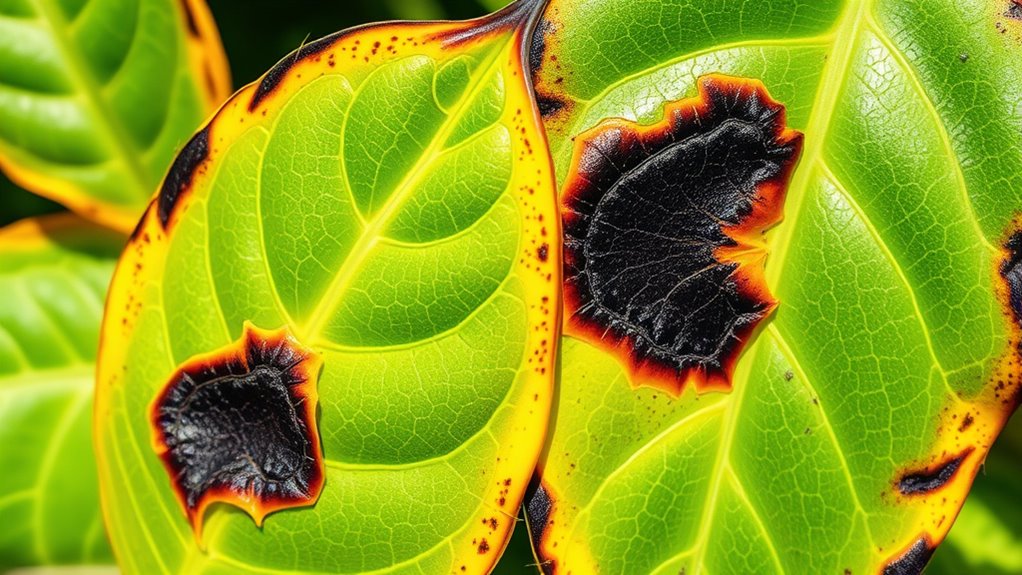
To treat and recover from leaf damage effectively, you need to recognize what caused the harm first. Taking immediate steps like removing damaged leaves and protecting your plant can prevent further injury. Recognizing the cause is crucial for applying the correct treatment, whether it’s sun scald or fertilizer burn. Proper diagnosis can also help you avoid common gardening mistakes that might worsen the problem. Long-term recovery involves proper watering, fertilization, and monitoring to guarantee your plumeria regains its health. Using appropriate well-being tips can also support overall plant vitality and resilience.
Identifying Damage Causes
When you notice plumeria leaves turning brown or showing burn marks, it’s vital to identify the underlying cause before attempting any treatment. First, examine the soil composition; compacted or poorly-draining soil can cause root stress, leading to leaf damage. If the soil retains too much moisture, overwatering becomes a suspect, causing root rot and leaf browning. Conversely, dry soil indicates underwatering, which also stresses the plant. Observe your watering techniques—frequent, shallow watering can lead to inconsistent moisture levels, while deep, infrequent watering encourages healthy roots. By evaluating these factors, you can determine whether sun scald or fertilizer burn is the culprit, or if improper watering and soil conditions are causing the damage. Proper diagnosis ensures effective recovery. Recognizing the signs of angel number soulmates can also help in understanding the overall health and harmony of your plant and environment. Additionally, understanding drainage and soil quality is essential for maintaining healthy plumeria growth and preventing future leaf damage. Ensuring optimal soil drainage can significantly improve your plant’s resilience against environmental stressors and damage.
Immediate Protective Actions
If you notice plumeria leaves burning or browning, taking immediate action can help prevent further damage and promote recovery. Start by carefully pruning affected leaves using proper pruning techniques to remove damaged tissue and improve airflow. This reduces the risk of pest problems and encourages healthy growth. Additionally, inspect the plant for pests and apply appropriate prevention measures, such as neem oil or insecticidal soap. Ensure the plant is shielded from harsh sun exposure by providing temporary shade or moving it to a less intense location. Keep the soil evenly moist but not waterlogged. Use the table below to visualize your protective steps:
| Step | Action | Purpose |
|---|---|---|
| Pruning | Remove burnt leaves | Reduce stress and pests |
| Pest prevention | Apply insecticidal treatments | Prevent infestations |
| Sun protection | Provide temporary shade | Minimize sun scald |
Additionally, understanding the difference between sun scald and fertilizer burn helps in diagnosing and treating leaf damage effectively. Recognizing the characteristics of fertilizer burn can prevent misdiagnosis and ensure appropriate treatment. Being aware of plant tissue damage can further aid in distinguishing the cause of leaf browning.
Long-term Recovery Tips
After removing the damaged leaves and addressing immediate pest and sun protection measures, focus on supporting your plumeria’s long-term health. Monitor leaf discoloration closely, as it indicates ongoing stress or nutrient deficiency. Adjust your watering practices to guarantee the soil remains moist but not waterlogged, as overwatering can cause further damage and root issues. Consistent, deep watering encourages healthy growth and recovery. Fertilize with a balanced, diluted fertilizer to promote new leaf development and overall vitality. Keep your plumeria in a location with partial sun to prevent future burns, and avoid sudden changes in environmental conditions. Proper soil management can significantly improve recovery outcomes. Additionally, understanding how plant stress responses influence leaf damage can help you better prevent future issues. Recognizing the importance of aesthetic wall organization can contribute to creating a healthy environment that supports plant health. Patience is key; with proper care, your plumeria can recover, develop healthy foliage, and regain its vibrant appearance over time.
Tips for Protecting Your Plumeria From Future Stressors
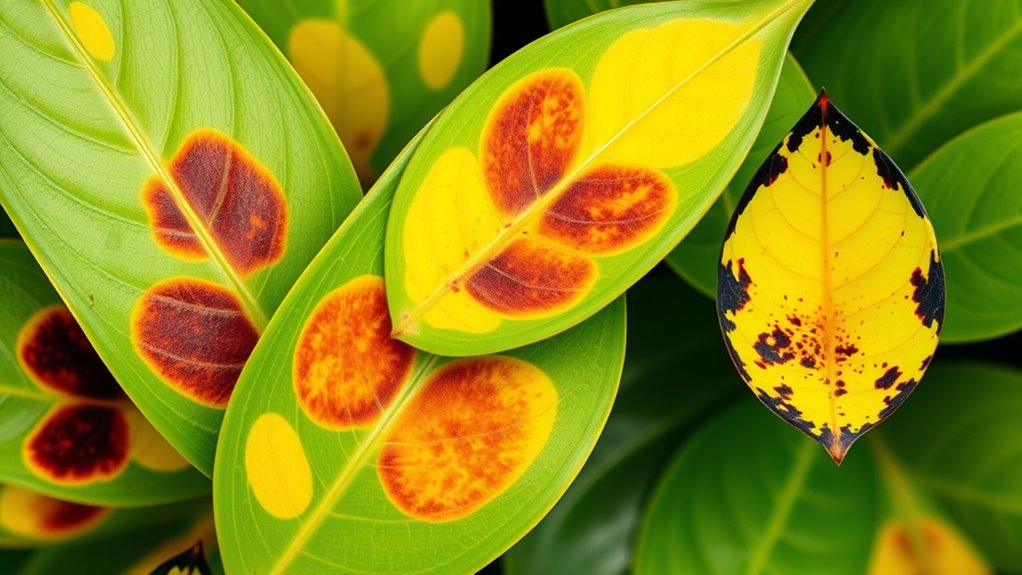
Protecting your plumeria from future stressors starts with proper site selection and environmental awareness. Choose a location with well-draining soil and plenty of sunlight, but avoid intense afternoon heat. Incorporate soil amendments like organic compost to improve soil health and stability, helping your plant withstand temperature swings and drought. Regular pest management is essential; inspect leaves and stems for pests and treat infestations promptly to prevent stress and damage. Mulching around the base helps retain moisture, regulate soil temperature, and reduce weed competition. Ensure your plumeria is well-watered during dry spells, but avoid overwatering. By maintaining healthy soil, managing pests effectively, and providing ideal growing conditions, you set your plumeria up for resilience against future stressors.
Frequently Asked Questions
Can Plumeria Leaves Recover From Sun Scald or Fertilizer Burn?
If your plumeria leaves have burned, you might wonder about leaf recovery. First, do a damage assessment to see if the leaves are just scorched or severely damaged. Sun scald typically causes localized damage, and leaves can often recover with proper care. Fertilizer burn might require you to flush excess nutrients and adjust your feeding routine. With patience and proper care, your plumeria can regain healthy foliage over time.
Are There Specific Fertilizers That Minimize Leaf Damage Risk?
When choosing fertilizers, opt for balanced, slow-release options to minimize leaf damage. Look for fertilizers with lower nitrogen levels, as high nitrogen can stress your plumeria. Combine this with proper sun protection by avoiding fertilizing during the hottest parts of the day and providing some shade if needed. This careful fertilizer selection and sun management help keep your plumeria healthy and reduce the risk of leaf burn or damage.
How Does Watering Frequency Affect Leaf Burn Severity?
Your watering habits directly impact leaf burn severity. If you water too frequently, soil moisture stays high, which can lead to root issues and increased susceptibility to fertilizer burn. On the other hand, infrequent watering causes drought stress, making leaves more vulnerable to sun scald. To prevent damage, maintain consistent soil moisture, water deeply when needed, and avoid overwatering, helping your plumeria stay healthy and vibrant.
What Are Natural Remedies to Soothe Damaged Plumeria Leaves?
You can soothe damaged plumeria leaves with natural herbal remedies and DIY treatments. Apply a diluted aloe vera gel to hydrate and calm the leaves, or use a chamomile tea rinse to reduce inflammation. Neem oil acts as an antifungal and healing agent, while a gentle milk spray can promote recovery. These natural solutions help restore your plant’s health without harsh chemicals, supporting overall leaf recovery and robustness.
Is Leaf Damage an Indicator of Underlying Root or Soil Issues?
You might think leaf damage is just cosmetic, but it often hints at deeper issues. Surprisingly, poor soil health or subtle root symptoms can cause leaves to burn or brown, revealing problems below the surface. Don’t ignore these signs; healthy roots and soil are essential for vibrant foliage. Addressing soil and root concerns now prevents more severe damage, ensuring your plumeria thrives instead of just survives.
Conclusion
Understanding the difference between sun scald and fertilizer burn helps you care for your plumeria better. While sun scald leaves turn crispy and pale, fertilizer burn causes dark, scorched patches—each tells a different story. By protecting your plant from harsh sun and following proper fertilization, you prevent damage. Treating leaf issues restores your plumeria’s beauty, but proactive care keeps it thriving. Remember, a healthy plant isn’t just about fixing problems—it’s about preventing them before they start.
